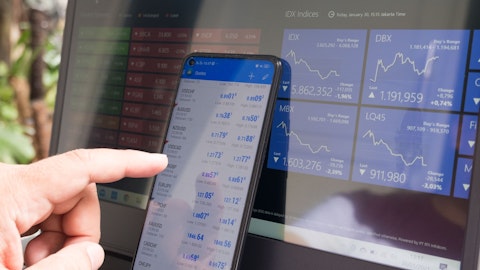Sibanye Stillwater Limited (NYSE:SBSW) Q4 2023 Earnings Call Transcript March 5, 2024
Sibanye Stillwater Limited isn’t one of the 30 most popular stocks among hedge funds at the end of the third quarter (see the details here).
Neal Froneman: Ladies and gentlemen, welcome to our 2023 H2 and Year End Presentation. Please take note of the international piggyback. We gave considerable thought as to what would be the appropriate way to signal our focus on the balance sheet and we thought this was the most appropriate way to indicate our focus. For a challenging 2024, we are not trying to create a silk purse out of a sow’s ear. So let’s move on. First of all, please take note of the safe harbor statement. There are lots of forward-looking statements, especially around what the markets may or may not do. What we intend to cover today is, I will go through the salient features of 2023. We want to start with it all starts and ends in the market. We really just want to focus on the PGM market.
I think that is the priority. We want to share with you our proactive focus and our protection of the balance sheet. That is definitely our priority for 2024. I will also discuss a concept that I introduced, at the last presentation, a little bit more on resource stewardship. I will then hand over to Charl Keita, our CFO, who will do the financial review. Charl will hand over to the Chief Regional Officers, Richard, Charles, Mika, and Robert for the operational review. And then I will pick up again to conclude today’s presentation. So let’s, just look at the salient features, for the year ended 31 December, 2023. I think in terms of embedding ESG as the way we do business and work, we certainly can celebrate a record low serious injury frequency rate.

Unfortunately, we did suffer regression in fatalities year-on-year, predominantly due to the Burnstone Conveyor contractor incidents — incident, where we unfortunately lost four human lives. We are pleased to say that we well advanced with our renewable energy projects with 267 megawatts in construction. We’re also pleased to say that we achieved conformance, for our storage facilities — tailing storage facilities according to GISTM. And in line with our capital allocation model, we established the Sibanye Stillwater Foundation and the first allocations for the benefit of social upliftment have been made. And Richard will cover that, in his section. In terms of financial performance, earnings and cash flow were significantly impacted by steep, a steep decline in PGM process.
We have been looking after our balance sheet not only recently, but for some time. And I’m pleased to say that we ended the year on a net debt to adjusted EBITDA ratio of 0.58x. We have a low risk and well stated — staggered, I should say, debt maturity ladder. And of course, we applied our dividend policy. But due to the losses in the second half of the year, there is no final dividend. In terms of the South African PGM operations, again, another really consistent and solid operational performance. We achieved industry leading cost control with only a 4% increase in our — all in sustaining costs to approximately R20,000 per 40 ounce. I want to point out, and Richard will do more of this, we — with the significant revenue generated by our byproducts and in particularly Chrome.
And I think that it’s not well understood how much revenue comes from chrome. But in terms of byproduct, credits, R10.9 billion it was the impact. Load curtailment was very well managed, and we ended up the year with effectively zero inventory, which is a good outcome considering what other, companies have had to report. We were proactive in restructuring many parts of our business. But in the South African PGM operations, we started just after mid-year results presentation, and that was — that restructuring was completed in February of 2024. The South African operations, I’m pleased to say, both gold and platinum are profitable despite, the depressed PGM basket price. In terms of South African gold operations, again, another good outcome.
See also Top 20 E-Commerce Companies in the World and 15 States Where You’re Most Likely To Get In A Car Accident.
Q&A Session
Follow Sibanye Stillwater Limited (NYSE:SBSW)
Follow Sibanye Stillwater Limited (NYSE:SBSW)
A very significant turnaround from a R3.5 billion adjusted EBITDA loss to a R3.5 billion adjusted EBITDA profit. That’s a R7 billion swing. Load curtailment was also managed, very well. Kloof 4 shaft was restructured again proactively, due to a constraint resulting from seismicity and the implementation of our safety strategy resulted in the closure of that shaft. Obviously, the final catalyst was a shaft accident in the shaft. The South African gold operations, as I’ve said, are also profitable and generating, a positive cash flow. Important, we often ask, why do we continue to pursue gold as part of our commodity mix? Well, I think it’s very clear in global economic downturns that, gold safe haven status is a positive. And just to note, if we could create value by growing our gold portfolio, we would.
Gold is a good commodity to have when you have a large base of industrial commodities as well. In terms of the U.S., the first half of 2023 was also impacted by a shaft accident at Stillwater West. We moved in quarter four to right size the operations for the lower palladium price environment that has worked extremely well. We’ve got another a number of other levers we can pull, and there’s ongoing work, to ensure that these operations become profitable. They’re still loss making at the moment. I will note when we look at reserves and resources that store is a strategic asset, both for ourselves as a company and for the U.S. And we have really no option but to ensure that it, becomes profitable even at these depressed palladium prices. So that’s not due for closure at this stage.
In terms of the European region, the construction of the Caliber Lithium Refinery is on schedule and on budget. Late last week, we received a court ruling on the appeal regarding the environmental permits, for both the Rapasaari mine and the concentrator. The court upheld the permit, but referred certain of those conditions back to the permitting authority. We suspect that may have an impact on when we bring Rapasaari mining to operation. And it may also require some rescheduling of capital. And once we have done that work and we are clear on the impact of this, we will provide the market with more guidance. The Sandouville nickel refinery in France was severely impacted by the collapse in nickel process. However, we had a very good outcome from the work that we initiated to look at the conversion of that refinery into a nickel sulfate, processing plant, incorporating battery recycling.
That study, as it was done morphed into a study on PCAM, on producing PCAM. And we had a positive outcome from that transition, and we will now take this to the next level of engineering. For the first time, we have I think a positive way forward for Sandouville. In the Australian region, again, good news. We completed the acquisition of New Century Resources. We now own a 100% of the company. The adjusted EBITDA turned positive in Q4 after the very extreme weather event in March of 2023. And we also ’23 to acquire a 100% of the Mount Lyell copper project. So let me move on to it all starts and ends in the market. And that’s a quote, from one of our previous Non-Executive Directors, Barry Davison. And as you know, Barry was instrumental in building Anglo Platinum, and we learned a lot from Barry.
And this is one of the — one of the things I would like to do acknowledge, that he taught us and Barry often listens into our calls. And, if you are listening in, Barry, greetings. I’m not going to get into the nuts and bolts of supply and demand as it relates to the PGM. I want to take more of a bit of a philosophical view of the market. Our view has been consistent. We recognize the issues of the day in very solid and very positive. And let me share with you why? The graph on the right hand side, indicates the makeup of light vehicle production by powertrains. On the left hand scale is millions of units of light vehicle production. And you can see the different colors indicate, what is ice? What is hybrids? What is BEVs, and fuel cells are hardly seen in this period.
The point that needs to be made is the following: is that absolute light-duty vehicle production is forecast to grow over the rest of this decade, to well in excess of a 100 million units per annum. I think the second point is that electric powertrains are expected to increase in market share in coming years. Now, that does mean that, battery electric vehicles will increase in market share. But for some time, we’ve been saying those penetration rates are overstated. But what seems to be forgotten is the role that hybrids will play and what’s becoming much clearer to us, as we get to understand supply constraints, consumer preferences, and technology advances. The use of PGMs in the hybrid and internal combustion engine segment to the market is well supported.
More recently, you had GM Ford, Toyota, BMW. And in fact, about a week, 10 days ago, Mercedes have all made public announcements pulling back on battery electric vehicle plants. And that type of messaging drive sentiment. Sentiment impacts short positions in the market. And from a palladium point of view, you are starting to see that unraveling. The point of all this is that, those technologies that use Autocts, and that’s ICE engines in the purest form and plug in hybrids, in this decade are expected to provide approximately 70% of the powertrain mix, which is a very solid underpin to the PGMs. I think that’s clear and it’s well understood that the majority of PGMs, especially platinum, ruthenium, and iridium have significant industrial underpin as well.
In other words, they’re not really impacted, by what happens in the Auto segment. So, again, another underpin to the demand side of PGMs. We do expect, primary supply cuts from loss making production. We’ve cut back 40,000, 50,000 ounces on shafts that have come to the end of their lives, on some loss making production. And I expect other companies will do exactly the same. So called recycling and extrapolating, recycling of AutoCAD in straight lines is not going to happen. Recycling remains subdued for very good reasons. There’s very little price incentive, to collectors. Logistics are difficult at the moment. People are not scrapping cars. The steel price is not underpinning the scrapping of cars either. So where we’ve ended up is in a bit of a volatile situation where supply chains have created major disruptions for end users who, through the experience, stocked up and built up inventory.




